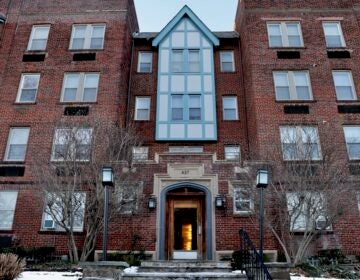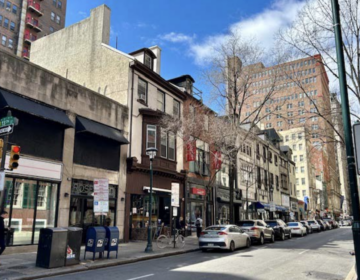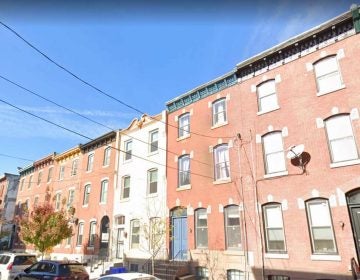Historical Commission adds to register, approves Old City apartment

The Philadelphia Historical Commission approved the construction of a new residential building in the Old City Historic District on Friday, and added 14 new properties to the city’s historical register. They represent the first new additions in more than a year.
Most of the subject buildings and properties are in the public or commercial realm, although a few — including one that provided the most contentious discussion — are private homes. The buildings include Joe Frazier’s gym, recently added to the National Register and the home of Dox Thrash, a prominent African-American artist, both in North Philly; a cultural mashup that pays testimony to Philadelphia’s diversity and includes an African-American burial site, a Jewish senior center, a Japanese House and Garden, a Chinese cultural center, a German Lutheran church; and the Center City homes of two iconic retailers, the stationer A. Pomerantz and automat Horn & Hardart.
As Commissioners ultimately gave nearly-unanimous nods to all of these properties, Commissioner John Mattioni steadfastly sought clarity on whether or not the Commission had heard from the owners involved. In many cases, said staffer Erin Cote, it had not, despite efforts to contact them. “I’m willing to go along with the designation,” Mattioni said at one point, referring to Stiffel, the Jewish center, “but with reservations whether it will have any impact.” In that case, Cote said, the owner had indicated he was opposed to the designation but had not appeared at the Nominating Committee’s meeting or the full Commission meeting.
One set of owners who did show up in vigorous opposition were the husband and wife who live in a Germantown property that was previously owned and altered by noted Philadelphia architect George T. Pearson. They made many of the same points voiced at the Nominating Committee meeting, citing their fear of reprisals from their mortgage lender, a devaluation of their home, and possible restrictions on them to do their own repairs in their own fashions.
Commission member Jon Farnham and some commissioners attempted to allay their fears, with Chair Sam Sherman saying that he lived in a historic district and had never had any mortgage issues. (Attorney Leonard Reuter, testifying on behalf of the Preservation Alliance, later claimed that not a single such case had ever occurred in the entire United States, but the applicants contended that today’s economic climate might compel lenders to look for reasons to call in loans.) Further. Sherman said, “the commission can be a resource and a partner — you shouldn’t view the jurisdiction of the commission as costing you more money.”
Just about everyone had something to say on this one.
Noting that case personified the “issues [of ownership compliance] that had been raised all morning,” Commissioner Anuj Gupta strove to strike a cautionary note about the wishes of the owners, while Commissioners Richardson Dilworth III and Commissioner Mattioni went head to head over the balancing act of public good and private rights. Commissioner JoAnn Jones read a letter from her then 83-year-old father who congratulated her upon purchasing a nearby historic property — “Darling, you are part of Germantown history” — while Commissioner Bob Thomas noted that he too lived in a historic property and understood that it did come with some burdens.
Ultimately, the Commissioners decided to approve the addition of the property to the register, with Mattioni and Gupta voting in opposition.
The other thirteen properties were designated unanimously. Ben Leech of the Preservation Alliance noted that the organization was responsible for six of the nominations and had helped underwrite research for two others. Four of the properties — Shofuso, the Japanese House and Garden, the Paschalville branch of the Free Library, Happy Hollow Playground and Rec Center, and Weccacoe Playground, the site of the African-American burial ground— currently belong to the City.
Along with Weccacoe, where the City is planning to invest $500,000 into greening and updates, the Pomerantz building is undergoing renovations by a developer planning to convert it into a 21-room hotel. It is currently vacant as, for the most part, are the Chinese Cultural and Community Center, Stiffel, and the Horn & Hardart building.
In offering comment on the designation of the St. Petri Evangelical German Lutheran Church, Sherman observed that the building “really goes to an issue we’ve been struggling with — places of worship. Here, we have an opportunity to designate something that is actually occupied.” The move, he continued, represents a “proactive rather than a reactive” stance. Leech added that it is “shocking” how few churches in West Philadelphia have been designated and that this represented a step in rectifying that.
In the Old City new construction case, architect Stuart Rosenberg presented the Commission with new plans that attempted to address many of the concerns of the Commission’s Architectural Committee. These included, according to staffer Randal Baron, a reduction of stucco, the addition of lintels and sills to the windows, more detailed cornices, and screened-in parking. But, Baron added, the request for the elimination of a setback on New and Letitia streets had not been honored. The Commission granted its approval with Architectural Committee Chair Dominique Hawkins the lone holdout.
WHYY is your source for fact-based, in-depth journalism and information. As a nonprofit organization, we rely on financial support from readers like you. Please give today.






